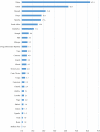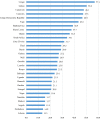Exploring health insurance and knowledge of the ovulatory cycle: evidence from Demographic and Health Surveys of 29 countries in Sub-Saharan Africa
- PMID: 37649040
- PMCID: PMC10466883
- DOI: 10.1186/s12978-023-01675-z
Exploring health insurance and knowledge of the ovulatory cycle: evidence from Demographic and Health Surveys of 29 countries in Sub-Saharan Africa
Abstract
Background: Unplanned pregnancy continues to be a major public health concern in Sub-Saharan Africa (SSA). Understanding the ovulatory cycle can help women avoid unplanned pregnancy. Though a wide range of factors for ovulatory cycle knowledge in SSA countries has not been well assessed, the influence of health insurance on ovulatory cycle knowledge is largely unknown. As a result, we set out to investigate the relationship between health insurance enrollment and knowledge of the ovulatory cycle among women of childbearing age. This study aims to investigate the relationship between health insurance enrollment and knowledge of the ovulatory cycle among women of childbearing age in sub-Saharan Africa (SSA).
Methods: Demographic and Health Surveys (DHSs) data from 29 SSA countries were analyzed. The association between health insurance and ovulatory cycle knowledge was investigated using bivariate and multivariate multilevel logistic regression models among 372,692 women of reproductive age (15-49). The findings were presented as adjusted odds ratios (AOR) with 95% confidence intervals (CI). A p-value of 0.05 was considered statistically significant.
Results: The pooled result shows that the prevalence of knowledge of ovulatory cycle in the studied 29 SSA countries was 25.5% (95% CI; 24.4%-26.6%). Findings suggest higher odds of ovulatory cycle knowledge among women covered by health insurance (AOR = 1.27, 95% CI; 1.02-1.57), with higher education (higher-AOR = 2.83, 95% CI; 1.95-4.09), from the richest wealth quintile (richest-AOR = 1.39, 95% CI; 1.04-1.87), and from female headed households (AOR = 1.16, 95% CI; 1.01-1.33) compared to women who had no formal education, were from the poorest wealth quintile and belonged to male headed households, respectively. We found lower odds of ovulatory cycle knowledge among women who had 2-4 parity history (AOR = 0.80, 95% CI; 0.65-0.99) compared to those with history of one parity.
Conclusions: The findings indicate that the knowledge of the ovulatory cycle is lacking in SSA. Improving health insurance enrollment should be considered to increase ovulatory cycle knowledge as an approach to reduce the region's unplanned pregnancy rate. Strategies for improving opportunities that contribute to women's empowerment and autonomy as well as sexual and reproductive health approaches targeting women who are in poorest quintiles, not formally educated, belonging to male headed households, and having high parity should be considered.
Keywords: DHS; Global health; Health insurance; Ovulatory cycle knowledge; Sub-Sahara Africa; Women’s health.
© 2023. BioMed Central Ltd., part of Springer Nature.
Conflict of interest statement
Dr. Sanni Yaya is an Editor-in-Chief of Reproductive Health and was not involved in the peer-review or handling of the manuscript. The authors have no other competing interests to disclose.
Figures
Similar articles
-
What has women's reproductive health decision-making capacity and other factors got to do with pregnancy termination in sub-Saharan Africa? evidence from 27 cross-sectional surveys.PLoS One. 2020 Jul 23;15(7):e0235329. doi: 10.1371/journal.pone.0235329. eCollection 2020. PLoS One. 2020. PMID: 32702035 Free PMC article.
-
Sexual violence and unmet need for contraception among married and cohabiting women in sub-Saharan Africa: Evidence from demographic and health surveys.PLoS One. 2020 Nov 3;15(11):e0240556. doi: 10.1371/journal.pone.0240556. eCollection 2020. PLoS One. 2020. PMID: 33141830 Free PMC article.
-
Individual and community-level determinants of knowledge of ovulatory cycle among women of reproductive age in 29 African countries: a multilevel analysis.BMC Womens Health. 2022 Sep 29;22(1):394. doi: 10.1186/s12905-022-01984-8. BMC Womens Health. 2022. PMID: 36175854 Free PMC article.
-
Prevalence and Determinants of Early Adolescent Childbearing in High Maternal Mortality Sub-Saharan Africa: A Multilevel Analysis of DHS Data.J Epidemiol Glob Health. 2025 Apr 22;15(1):63. doi: 10.1007/s44197-025-00409-7. J Epidemiol Glob Health. 2025. PMID: 40261517 Free PMC article.
-
Association between women's household decision-making autonomy and health insurance enrollment in sub-saharan Africa.BMC Public Health. 2023 Mar 30;23(1):610. doi: 10.1186/s12889-023-15434-z. BMC Public Health. 2023. PMID: 36997885 Free PMC article.
Cited by
-
Demographic and socio-economic correlates of knowledge of the ovulatory cycle among tribal women in India: Evidence from the nationally representative survey (NFHS-5).BMC Public Health. 2024 Mar 12;24(1):766. doi: 10.1186/s12889-024-18296-1. BMC Public Health. 2024. PMID: 38475774 Free PMC article.
-
Knowledge of the ovulatory cycle and its determinants among women of reproductive age in Papua New Guinea: Insights from a population-based study.PLoS One. 2025 May 28;20(5):e0324255. doi: 10.1371/journal.pone.0324255. eCollection 2025. PLoS One. 2025. PMID: 40435121 Free PMC article.
References
-
- Hampton K, Mazza D. Fertility-awareness knowledge, attitudes and practices of women attending general practice. Aust Fam Physician. 2015;44(11):840–845. - PubMed
-
- Babbar K, Dev P. Modelling the impact of Ovulatory Cycle Knowledge on the number of children and age of women at first birth.
-
- Holesh JE, Bass AN, Lord M. Physiology, Ovulation. In: StatPearls [Internet]. Treasure Island (FL): StatPearls Publishing; 2022 [cited 2023 Mar 13]. Available from: http://www.ncbi.nlm.nih.gov/books/NBK441996/. - PubMed
-
- American Pregnancy Association (ASA). American Pregnancy Association. 2022 [cited 2023 Mar 13]. What is Ovulation? Available from: https://americanpregnancy.org/getting-pregnant/infertility/understanding....
MeSH terms
LinkOut - more resources
Full Text Sources
Medical
Research Materials



